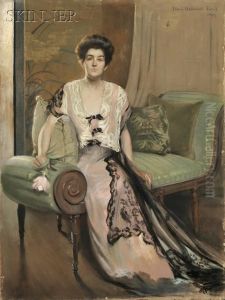May Hallowell Loud Paintings
May Hallowell Loud was an American artist born on March 23, 1860, in Hallowell, Maine. She grew up in a family that encouraged education and artistic pursuits. Her father, a successful businessman, and her mother, a culturally inclined homemaker, both supported her interest in art from a young age. May Hallowell showed talent in drawing and painting early on and sought to develop her skills through formal education in the arts.
Loud pursued her artistic education at the School of Design for Women, which later became part of the Moore College of Art and Design in Philadelphia. She was one of the early students of the prominent artist and teacher Thomas Eakins, who was known for his realist paintings and innovative teaching methods. Eakins' influence is evident in Loud's work, particularly in her attention to anatomical accuracy and her interest in capturing the human form with a sense of vitality and realism.
After her studies, Loud traveled to Paris to further her education, which was a common practice for American artists at the time. In Paris, she continued to refine her skills and was exposed to a variety of artistic styles and movements. She exhibited her work at the Paris Salon, an important venue for artists seeking recognition and critical acclaim. Her time in Europe significantly shaped her artistic style and broadened her perspectives on art.
Upon returning to the United States, Loud became an active member of the art community. She was involved with several art organizations and frequently exhibited her work. Her paintings often featured portraits, landscapes, and genre scenes that reflected her technical skill and understanding of light and color. Loud's contribution to American art during the late 19th and early 20th centuries was part of the broader cultural development of the period, as American artists sought to establish their own identity and artistic language.
May Hallowell Loud's career was cut short by her untimely death on July 6, 1916, in Pasadena, California. Despite her relatively short life, she left behind a body of work that continues to be appreciated for its craftsmanship and place within the context of American art history. Her legacy is also tied to the advancement of women in the arts, as she was part of a generation of female artists who helped pave the way for greater recognition and opportunities for women in the field.
